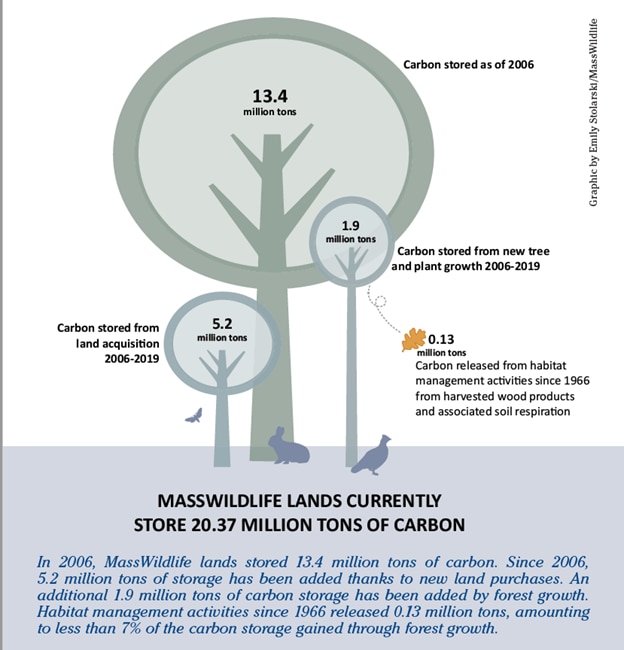MassWildlife is proud to incorporate climate change adaptation principles into our mission to conserve biological diversity in Massachusetts. We apply science-based habitat restoration and management practices today that anticipate emerging conditions under climate change in the future.
Climate change is driven by increased concentrations of greenhouse gases, mainly carbon dioxide, in the atmosphere. Forests reduce greenhouse gasses by storing large amounts of carbon as they grow. In fact, the carbon storage capacity of forested lands that are protected from development, gets larger with every passing year (Figure 1). By protecting and managing the 168,000 acres of Wildlife Management Areas (WMAs), MassWildlife plays a substantial and growing role in helping the Commonwealth meet its greenhouse gas emission reduction goals. Land protection and management are also critically important for the conservation and restoration of wildlife habitat, including habitats for our most vulnerable plants and animals.
Figure 1. MassWildlife lands have a net annual increase in carbon storage even after accounting for carbon release associated with habitat management activities.
Although most (78.8%) of WMAs is maintained as forest, many types of wildlife rely on open habitats, including declining populations of shrubland songbirds, native pollinators, and other Species of Greatest Conservation Need identified in the State Wildlife Action Plan. By managing a limited portion of our land as grassland, shrubland, and young forest habitat, MassWildlife ensures that all of the Commonwealth’s wildlife can thrive. Shrubland and grassland habitat restoration may involve removing trees, and although some carbon is released during management, the carbon budget analysis for MassWildlife lands shows that carbon storage provided by forest growth far exceeds loss (Figure 2).
Carbon Budget for Wildlife Management Areas
In 2006, a forest inventory was completed to estimate the amount of carbon stored on WMA lands . At that time, MassWildlife lands stored over 10.3 million tons of carbon (Figure 2). Since 2006, an additional 2.6 million tons of carbon were added to MassWildlife lands through land protection, and another 1.2 million tons of carbon were removed from the atmosphere and stored on MassWildlife lands as a result of forest growth (Figure 2). Altogether, MassWildlife lands currently store over 14 million tons of carbon.
Since 2006, about 0.02 million tons of carbon has been released as a result of habitat management on MassWildlife lands, compared to 1.2 million tons of carbon have been stored on MassWildlife lands through forest growth (Figure 2). Carbon loss through habitat management for rare and declining species is just 1.7% of new carbon storage by growth on WMAs.
Carbon budget for MassWildlife properties
Figure 2.
Summary of Key Findings
- Land protection plays a critical role in helping the Commonwealth meet its greenhouse gas emission reduction goals, while improving our health and quality of life, and providing vital wildlife habitat and recreational opportunities.
- Habitat restoration and management practices conserve rare and declining animal and plant species while providing renewable wood products that have potential for long-term carbon storage and support local economies.
- Through sound management of predominantly forested lands, MassWildlife stores large amounts of carbon and contributes to the Commonwealth’s climate change mitigation strategy, while managing a limited portion of its land as grassland, shrubland, and young forest for the people to enjoy and wildlife to thrive.
- When wood is harvested as sawtimber, about 50% of that volume goes into long-term use as finished wood products (furniture, flooring, structural timbers, etc.) that continue to store carbon. In addition, emerging technologies are making use of wood that would otherwise be burned as biofuel. For example, cross-laminated timbers now allow for construction of wood-based buildings approaching 20 stories in height. The total carbon cost of these new wood buildings can be substantially less than similar buildings built of steel and/or concrete.
- Click here for background details on the MassWildlife carbon budget.
Read the Massachusetts Wildlife magazine article Carbon and Conservation on MassWildlife Forest Lands.

